New Trip Report: Ghana (including 2 Pangolin species)
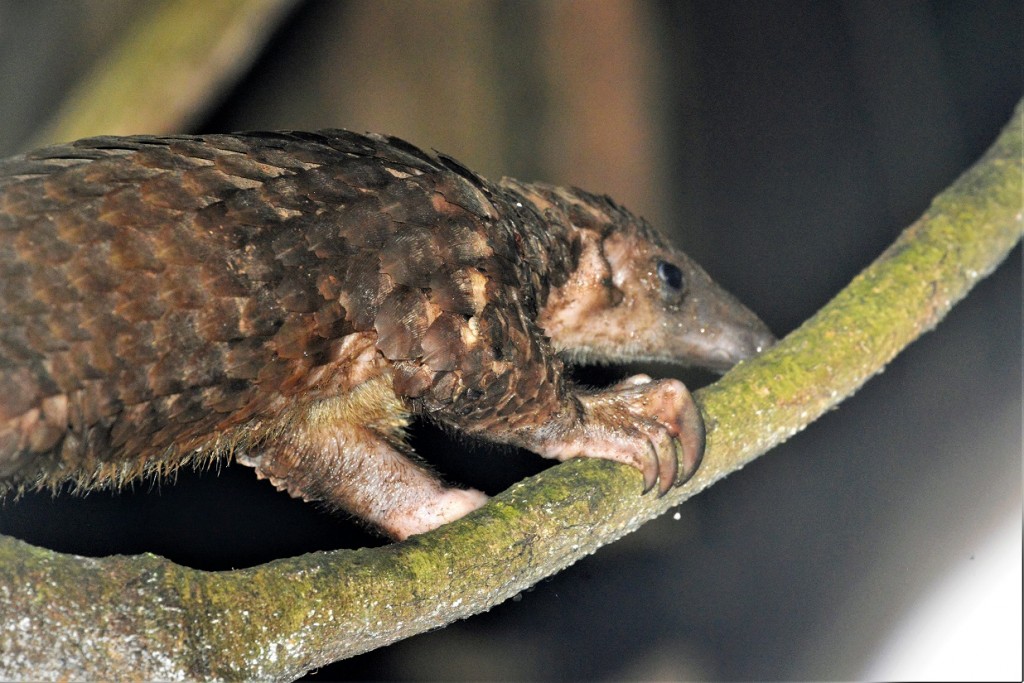
White-bellied (Tree) Pangolin
Phil’s Two Pangolin Tour of Ghana
submitted by Ian Thompson
At Birdfair last year, Mark from Ashanti African Tours had told Phil Telfer that, given a week, he could find him a pangolin in the wild in Ghana. Phil gave him 10 days and the deal was sealed.
Our group consisted of Phil Telfer, Holly Faithfull, myself and Tracey Watchurst, my partner. We met up in Amsterdam and had an uneventful flight to Accra, arriving about 7:30 PM. The first reminder we were back in Africa occurred when we got out of the plane to be greeted by the warm, humid, fragrant air of the tropics. The second reminder came in immigration. I had neglected to bring my yellow fever immunization certificate. This evoked clucks of disappointment from the health staff at the airport, where Tracey and I were escorted into several rooms while various members of the Ghana Health Authority asked us what we were going to do about our huge problem. Our protestations that one had to provide yellow fever immunization certificates in order to obtain a visa were countered by suggestions that that was a completely separate arm of government and that the health authority could certainly not accept that as proof of immunization. One woman suggested the problem could be solved by buying her a very large supper. After about an hour of polite but firm negotiation they grew tired of us and we were able to proceed to the baggage claim area. We were then met by Andrew and Ibrahim, our guides, and Ansari, our driver. We stopped for pizza and fried chicken and then headed out to the Rain Forest Lodge in Jukwa, just south of Kakum National Park. My most vivid memory of the evening is the unbelievable number of churches in Ghana. I recently saw a study claiming that Ghana was the most religious country in the world, followed by Nigeria and Armenia. Certainly every second building appeared to be a church and I’ve never seen so many billboards advertising a variety of messiahs, prophets and preachers.
We arrived at the Rainforest Lodge about 1:30 AM. The name is a bit of a misnomer as the hotel is actually located at the north end of Jukwa in a large compound in which almost all trees have been cut down. From here it is a bumpy 25 minute drive to Kakum National Park, a drive which we were to make frequently over the next three days. We arrived at the park about eight o’clock in the morning. From the car park there is perhaps a 20 minute walk to the canopy walkway, the centrepiece of the park. We saw Green Bush Squirrel and Fire-footed Rope Squirrel along the way. Stepping onto the canopy walkway we had a good look at a pair of Slender-tailed Squirrels. A large tree viewable from platform three revealed Red-legged Sun Squirrels. The rest of the morning was quiet from a mammal point of view. After lunch and a nap back at the hotel we returned to the canopy walkway that afternoon. We stayed on the walkway until dusk and then walked back through the forest, seeing several Demidoff’s Galagos. We also had a close-up look of a very small spitting cobra just before the start of the canopy walkway. Back at the car park we had a good look at Bosman’s Potto and a brief look at a Lowe’s Monkey bedding down for the night. We returned for a lengthy night hike. We saw couple of Emin’s pouched rats, and two different climbing mice. We also got a good look at Thomas’s Galago and perhaps most surprisingly, a good look at a Western Tree Hyrax which froze on the slanted trunk of the tree as we approached. Around the car park we also saw a hopping mouse and a rat which on close inspection appeared to be Rattus rattus. Reptiles for the night included a dwarf crocodile and an African Mud Turtle.
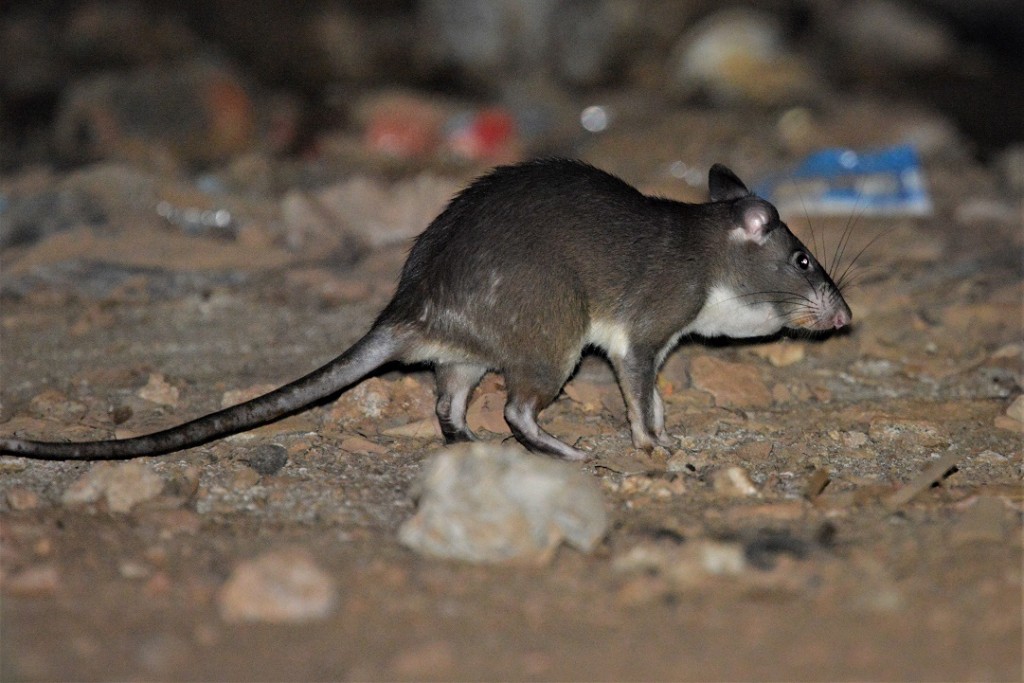
Emins’ Pouched Rat
The next morning we were at the canopy walkway considerably earlier and saw Gambian Sun Squirrel and Red-legged Sun Squirrel. On the walk back to the bus we found a couple of Hammer-headed Fruit Bats. The park headquarters revealed a habituated African Giant Squirrel. Still no monkeys, which was making Phil a little bit nervous. After lunch, we walked along the trail deeper in the park but saw no mammals. We did however see tracks of duiker. There was a brief rain shower and we returned to the canopy walkway. Success! A large mixed troop of Olive Colobus, Lesser Spot-nosed Monkeys and Lowe’s Monkeys was moving through the forest, nicely visible from platform number three. We spent a couple of hours watching them and then headed back to platform number one. In a dead tree close to platform one is a colony of Pel’s Anomalures. We watched them come out of the holes in the trunk and launch themselves into the air. One appeared to be gliding straight at us before sharply veering off to the left. Really impressive. The night walk that night revealed a couple of African dormice, a climbing mouse which appeared different than the previous night, another pouched rat, and two pottos as well as another viewing of Rattus rattus.
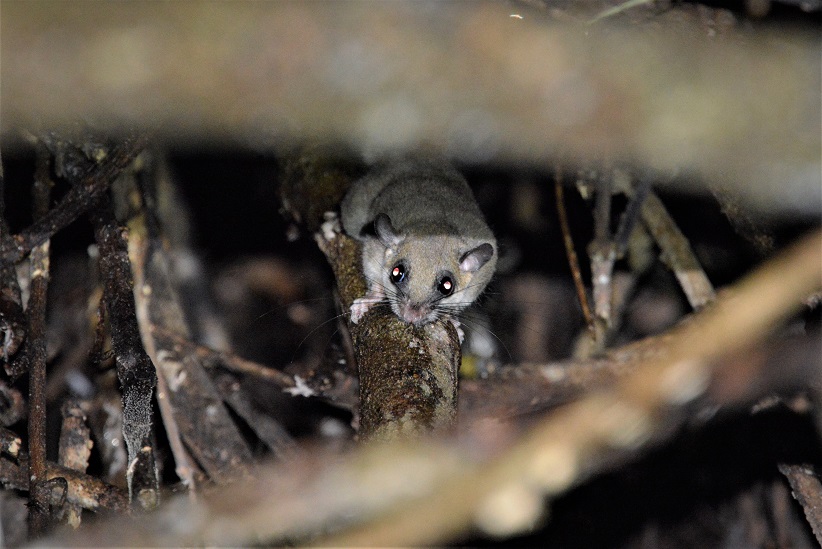
Nagtaglas’s (West African Smoky) Dormouse (probably)
Our third morning in Kakum produced Slender-tailed Squirrel, a couple of bats in culverts and a bat in a hollow tree. Any identifications would be most welcome. Hiking through the forest we got a good but brief look at a Common Cusimanse and a very brief glimpse of Maxwell’s Duiker. Our evening walk produced a Tree Civet/African Palm Civet, another pouched rat, three or four pottos, Pel’s Anomalure, another as yet unidentified mouse and a mother and baby wrinkle-nosed bat on the trunk of a tree.
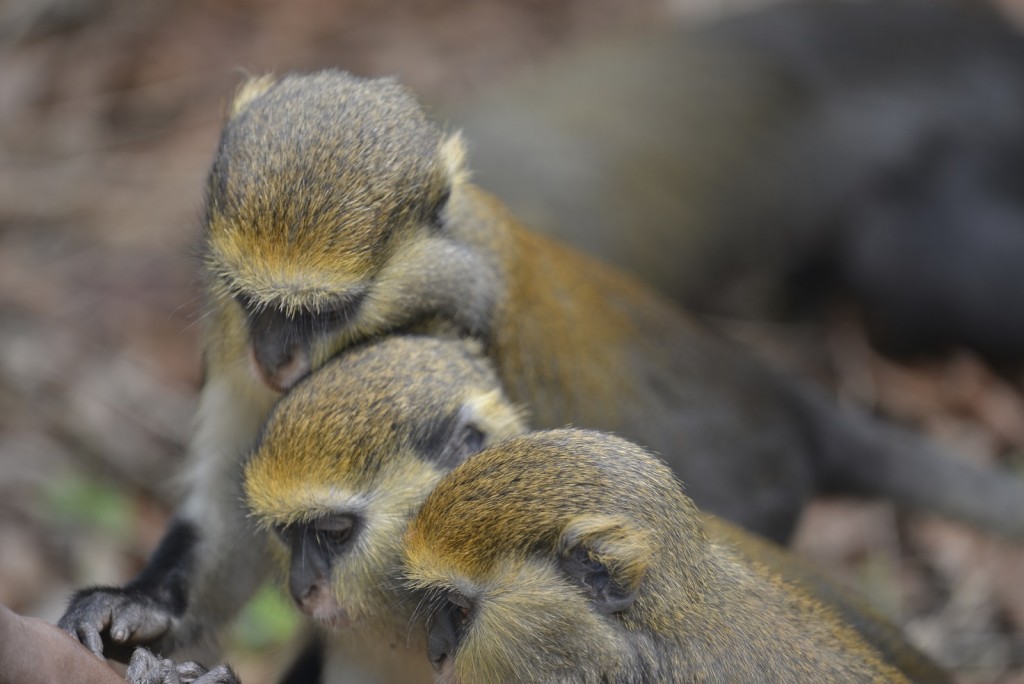
Lowe’s Monkey
The next morning we drove to Bonkro, best known as probably the most accessible site for Yellow- Headed Picathartes but also, according to Mark, a promising pangolin-spotting site. We checked into Tina’s Holiday Inn in a neighbouring town. I was concerned that Tina might get sued for copyright infringement, but reassured myself that there were enough differences between this establishment and its namesake to make confusion unlikely. We headed off into the forest near the village of Bonkro. Andrew saw an African Giant Squirrel and we all had brief looks at Fire-footed Rope Squirrel. We made an afternoon pilgrimage to the Picathartes site to watch the birds coming back to their nests at about dusk. Although perhaps classified by some as bycatch on a mammal-watching trip, the birds were impressive enough that we elevated their status to that of honorary mammals. That evening we saw a Flying Calf, pouched rat, two mice, an African dormouse and several Demidoff’s Galagos.
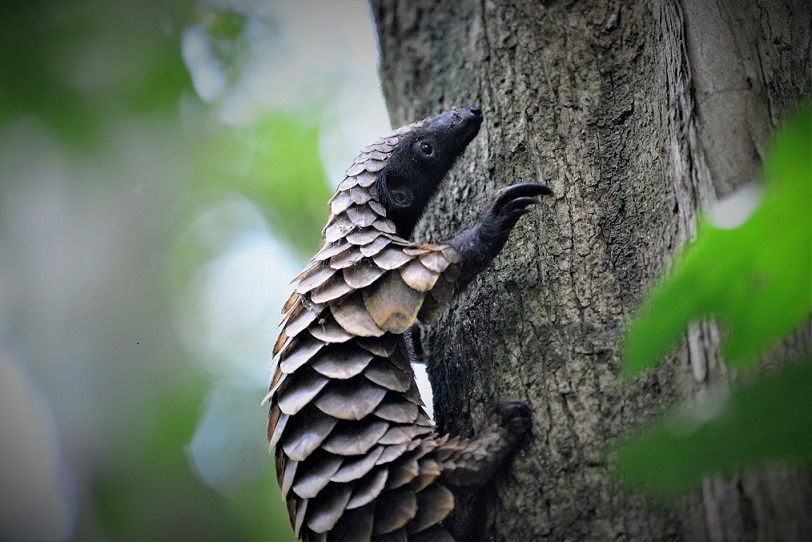
Black-bellied (Long-tailed) Pangolin
Our second day in Bonkro we tried a bit of a different technique and our local guide, Kwame, went off into the forest while we followed Andrew on the trail. After a short while we heard vigorous calls and caught up with Kwame to find him pointing at a Long-tailed Pangolin climbing a branch. We were able to observe it for more than an hour. Just in case anyone missed a good look the pangolin grasped a broken branch and fell about 40 feet from the canopy. Much concern about its well-being, but when we backed off a few feet it righted itself and proceeded to climb up the tree as if nothing it happened. Our evening walk produced another good sighting of Western Tree Hyrax, another aboreal mouse, several Demidoff’s Galagos, wrinkle-nosed bats and Pel’s Anomalure. It was probably about 11 o’clock when we heard calls from Andrew. We ran over to where he was standing for a good look at a Tree Pangolin on the ground. Pangolin species number two, for those who are counting. We also found an Eroded Hinged-back Tortoise.
The next morning Andrew, Ibrahim and I went back to check out a bat roost. This proved to be Wrinkle-nosed bat again. We also had a look at a zebra mouse running across the road.
We then drove to Bobiri Forest and checked into the guesthouse. The rest house is in quite a peaceful location about 3 km from the nearest village. The forest appears to be in quite good shape with numerous large trees. However there is significant hunting pressure and from a mammal spotting perspective it’s a bit of a disappointing site. We did get a glimpse of Fire-footed Rope Squirrel that afternoon. Heavy rain sentenced us to bed early without a night hike. The next morning we arose before dawn and were treated to a good look at a Beecroft’s Anomalure just in front of the rest house. We did a lengthy hike through the forest in the morning. Andrew saw an African civet with its infant but none of the rest of us managed a look. We found a second tortoise, Hume’s Hinge-backed Tortoise. On the evening walk we saw Pel’s Anomalure, Straw-coloured Fruit Bat, Demidoff’s Galago and a Hammer-headed Fruit bat. Holly who kept hiking later than the rest of us also saw another Thomas’ Galago.
The next morning we did a day trip to the community monkey sanctuary at Boabeng-Fiema. The community protects the monkeys of the local forest. Lowe’s monkeys and White-thighed Colobus/Geoffrey’s Pied Colobus are easy to observe at close range. In fact, at this stage, the site is probably the only spot where White-thighed Colobus is easy to observe these days. The drive to the sanctuary passes through areas of savannah revealing a different suite of birds than the forest sites we had seen so far. That evening there was again heavy rain and so no night walk. Instead we went for a walk at 4 o’clock in the morning and saw a young Beecroft’s Anomalure, more Pel’s Anomalures and Demidoff’s Galagos. After breakfast we drove towards Shai Hills stopping for a Straw-coloured Fruit Bat roost in a large tree. We spent a couple of hours driving around Shai Hills Resource Reserve and saw numerous kobs and Olive Baboons. We also visited Suya caves, where there is a large colony of Egyptian Tomb Bats (thanks to Fiona Reid for the identification). The surprise of the afternoon was seeing a Lesser Spot-nosed Monkey in a tree close to the bat caves.
We then drove back to Accra dropping off Phil and Holly for their flight back to England. Tracey and I spent the night in Cape Coast and then continued on to Butre for a couple of nights on the beach. The only new mammal seen was Striped Ground Squirrel. We did an early morning canoe trip up the Butre River through the mangroves and saw numerous crabs, mud skippers (locally called “flog-fish”) and a monitor lizard. We visited a couple of the old slave forts and then headed back to Accra to begin the long trek home.
In summary it was good trip. I can’t praise our guides from Ashanti African tours enough. They were unfailingly enthusiastic and quite happy to hike as long as any of the rest of us cared to. Their knowledge of the local wildlife including bird calls and butterflies was outstanding. If there was a downside, the profusion of bushmeat for sale beside the highways in Ghana gets a bit depressing. As well as duikers and cane rats, we saw such unpalatable fare as genets for sale. If anyone else is planning a similar trip I would suggest perhaps substituting a couple of days in Ankasa in the far west rather than Bobiri Forest. There has been some poaching and encroachment into Ankasa forest but I believe it would still offer more potential than Bobiri. For savannah mammals, Mole National Park in the north of Ghana is probably one of the best sites for savannah mammals in West Africa at the present. Andrew tells me that work is proceeding on hiking trails and tented camps in the interior of Kakum Park. When these will be completed to anyone’s guess, but they certainly sound promising for more elusive forest species.
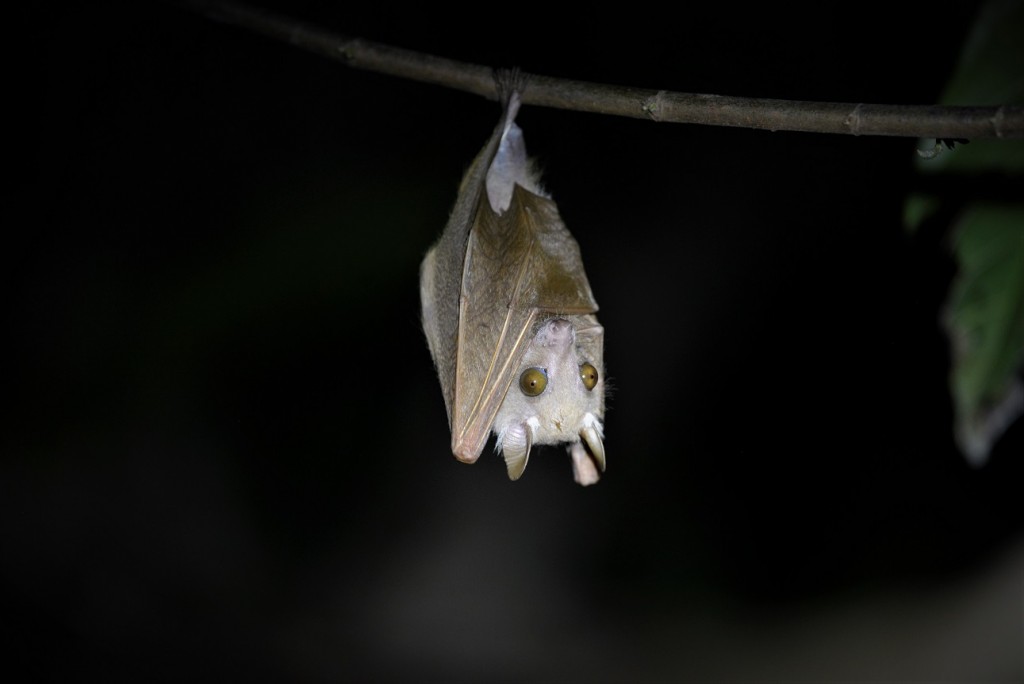
Flying Calf
The following Latin names are taken from the second edition of the Kingdon Field Guide to African Mammals. There are several rodent and bat species not yet identified. I will post pictures when I get a chance. Please feel free to correct me if I have made any errors.
Mammal List:
- Western Tree Hyrax (Dendrohyrax dorsalis)
- Olive Colobus (Procolobus verus)
- Geoffrey`s Pied Colobus/White-thighed Colobus (Collobus vellerosus)
- Olive Baboon (Papio anubis)
- Lowe’s Monkey (Cercopithecus (mona) lowei)
- Lesser Spot-nosed Monkey (Cercopithecus (cephus) petaurista)
- Bosman’s Potto (Perodicticus potto)
- Demidoff’s Galago (Galagoides demidoff)
- Thomas’s Galago (Galagoides thomasi)
- Red-legged Sun Squirrel (Heliosciurus rufobrachium)
- Gambian Sun Squirrel (Heliosciurus gambianus)
- African Giant Squirrel (Protoxerus stangeri)
- Slender-tailed Squirrel (Allosciurus aubinnii)
- Fire-footed Rope Squirrel (Funisciurus pyrropus)
- Green Bush Squirrel (Paraxerus poensis)
- Striped Ground Squirrel (Xerus erythropus)
- West African Smoky Dormouse (Graphiurus nagtaglasi)
- Pel’s Anomalure (Anomalurus peli)
- Beecroft’s Anomalure (Anomalurus beecrofti)
- Emin’s Pouched Rat (Cricetomys emini)
- African Climbing Mouse (Dendromus sp., most likely melanotis)
- Black Rat (Rattus rattus)
- Zebra Mouse (Lemniscomys sp.)
- Straw-coloured Fruit Bat (Eidolon helvum)
- Hammer-headed Fruit Bat (Hypsignathus monstrosus)
- Flying Calf (Nanonycteris veldkampi)
- Egyptian Tomb Bat (Taphozous perforatus)
- wrinkle-nosed bat/roundleaf bat/leaf-nosed bat ( Hipposideros sp.)
- Tree Civet/Common Palm Civet (Nandinia binotata)
- Common Cusimanse (Crossarchus obscurus)
- Long-tailed Pangolin (Uromanis tetradactyla)
- Tree Pangolin ( Phataginus tricuspis)
- Maxwell’s Duiker (Philantomba maxwelli)
- Kob (Kobus kob)
10 Comments
-
tomeslice
Hey Jon!
I’m happy to see that you finally got yourself the white-bellied pangolin!!
Didn’t you see the black-bellied one for the first time when you were in Ghana too?I guess it’s worth mentioning that Sangha Lodge would be another good place to see both species. They have some habituated black-bellied ones, but Tamar will occasionally ask her Ba’aka team to track down a completely wild one for research purposes (observation only, of course) and they often succeed.
Anyway, good report! Cheers!
-
-
-
Jon Hall
Murray, I would think your best bet is to contact the Afribats project https://www.inaturalist.org/projects/afribats
As you know I am sure it might be very hard to ID the calls but the crew there are really responsive and will give you good advice.
-
Leave a Reply
You must be logged in to post a comment.


samuel
Wow !! Ghana is definitively looking more and more attractive to me as a nice vacation destination… Very nice trip report Ian. Thanks